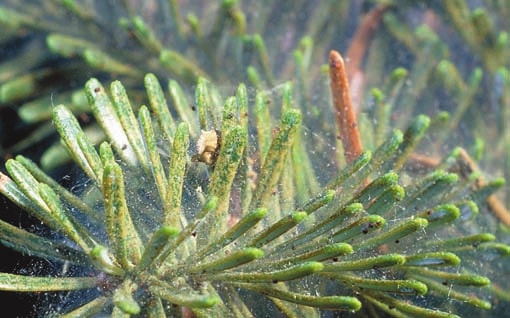Introduction
Spruce spider mite (Oligonychus ununguis) is a small pest that infests numerous conifers. The insect is native to North America. It is one of the most destructive spider mites in the United States. Spruce spider mite is most active in spring and fall, when temperatures are cool. When conditions are favorable, spider mite populations can accumulate quickly, and devastate plants. Severely infested plants often experience widespread foliar dieback. If the spider mites are not tended to, some trees may succumb to infestation.
Distribution & Habitat
Spruce spider mite is prevalent across the United States. It may appear wherever susceptible plants are present.
Hosts
Spruce spider mite infests a wide range of plants, including arbovitae, cedar, dawn redwood, hemlock, larch, juniper, pine, and other conifers. Dwarf Alberta, Colorado blue, Norway, and white spruce are the insect’s preferred hosts.
Description
The eggs laid by spruce spider mite are oval to circular in shape. They range from reddish-orange to brown in coloration. The nymphs are pale green mites. They resemble the adults, but are smaller, and only possess three sets of legs. As the nymphs mature, they molt several times. During this period, their color darkens, turning dark green to dark brown. The adults are larger, measuring up to 0.5 mm in length. By the time they have matured, the adults form an additional pair of legs, as well as an abundance of pink-colored spines that cover the body.
Life Cycle
Spruce spider mite produces seven to ten generations per year. The eggs overwinter in and around bud scales, in bark crevices, and at the base of needles. From mid-March to late April, just prior to bud expansion, the eggs hatch, revealing masses of tiny nymphs. Shortly after hatching, the nymphs migrate to the older needles located in the inner section of the crown, and commence feeding. When temperatures exceed 90°F, the nymphs slow their feeding to mate. Upon mating, the females lay eggs along the infested plant. These eggs hatch in fall, when temperatures have cooled.
Spruce spider mites can reach maturity in 15 to 20 days. Generations often overlap, with mites of all stages communing on the same plant. Some nymphs construct silken webs that they use for shelter. When feeding, the nymphs will avoid consuming the current year’s growth until late summer, when it has hardened off. In late fall, when temperatures plummet, the eggs that have yet to hatch overwinter.
Symptoms of Infestation
Infested plants will assume a mottled or stippled appearance. Older needles will become discolored, turning a pale yellow. By mid-summer, most infested needles will turn red. By this point, many infested needles will drop prematurely. As the growing season progresses, discoloration may spread throughout the plant’s crown. Fine, silken webs can often be observed on infested needles from late spring to fall. Severely infested plants may experience significant foliar dieback. Trees that have been weakened by environmental stressors, diseases, or others infestations may collapse.
Management
- Monitor plants that are vulnerable to infestation in early spring and early fall. If a plant’s foliage exhibits discoloration symptoms, perform a thorough inspection of the plant to determine if spruce spider mites are present. To do so, tap the suspected branch against a single sheet of white paper. If the branch is infested with mites, they will be dislodged by the sudden motion. If more than ten mites are observed on a branch, assess three to four more sections of the plant using the same method. If additional mites are discovered, apply a registered miticide to prevent them from breeding. Early spring is the most ideal period to administer miticides. A subsequent application can be performed in September if mite populations persist.
- Dousing infested plants with a strong stream of water can eliminate spider mites at all stages.
- Insecticidal soaps and horticultural oils can be utilized in spring to suppress the eggs and nymphs.
- Neem or pesticides registered for use in the control of spruce spider mite can be applied in fall to eradicate the adults.
- In fall, if infestations are severe, apply a dormant oil spray in mid-winter to kill the overwintering eggs.
- Maintain plant vigor through sound cultural practices. Ensure that plants are sufficiently watered, especially during extended periods of drought. Apply a layer of organic mulch around the base of susceptible plants to improve the soil quality, moderate the soil temperature, and retain soil moisture.
Photo courtesy of Ohio State University


